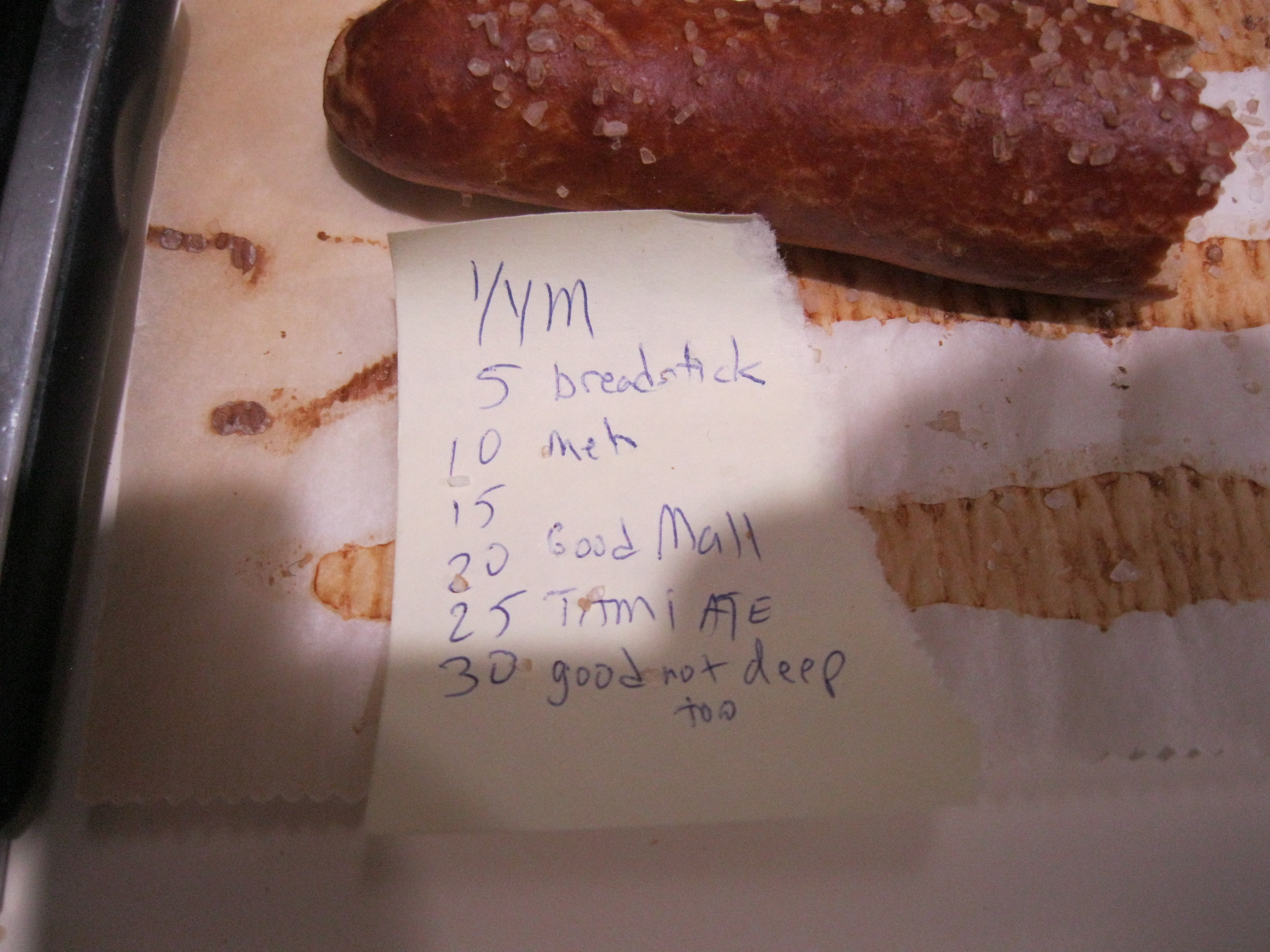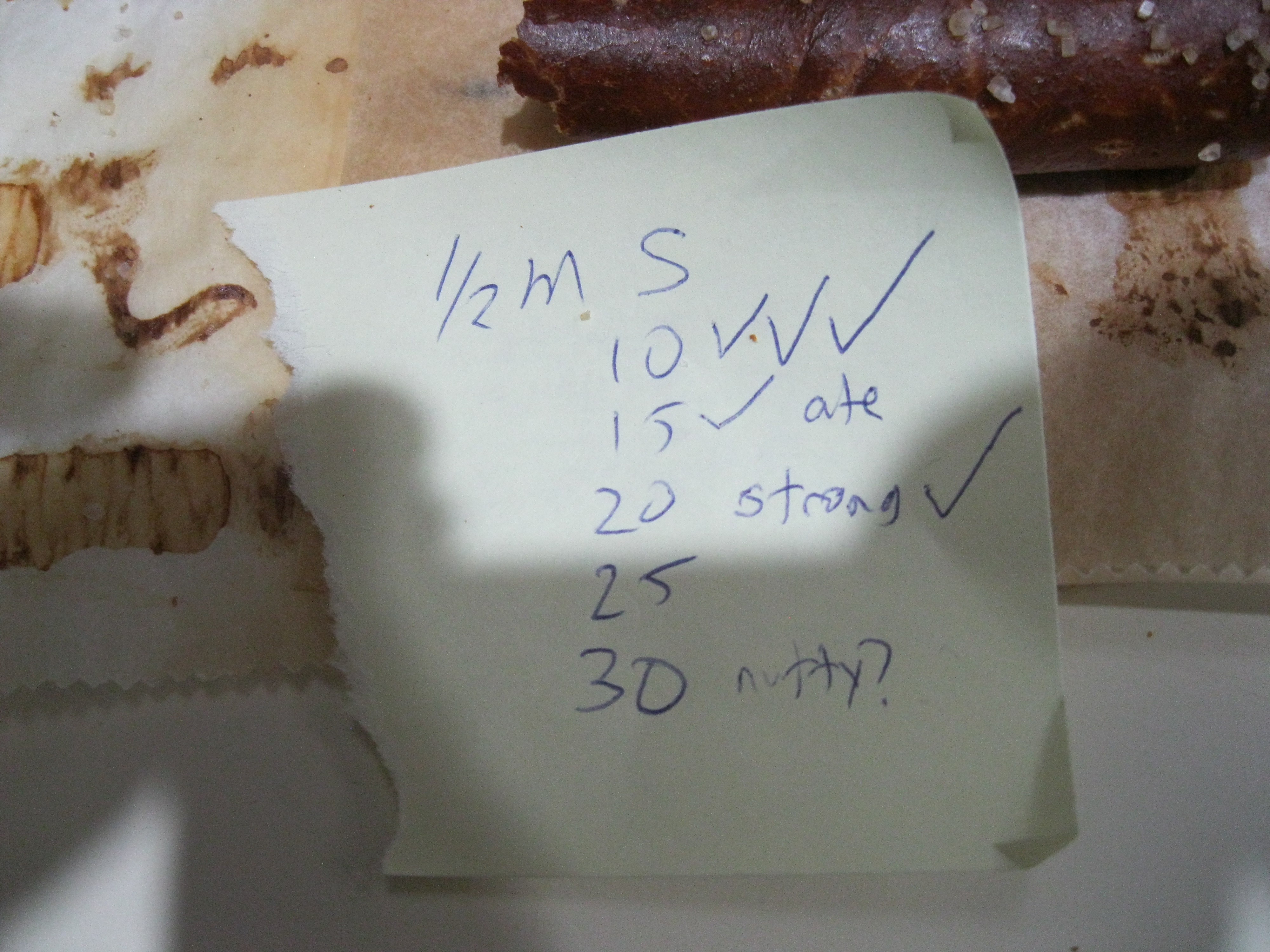 Saturday - August 15, 2020
Saturday - August 15, 2020
Rhubarb !!!
She came home from work with an armload of rhubarb that a coworker had brought in from their garden.
I haven’t had rhubarb in ... probably 45 years. Pretty sure my parents used to grow it in the vegetable garden, but that’s loooong ago in the past.
So we’re making strawberry rhubarb pie, and, since we have so much of the stuff, we’re making a strawberry rhubarb crumble as well. Both are a great excuse to get hold of some good vanilla ice cream.
Rhubarb has an unusual taste, but it’s one that I’ve always loved. Can’t wait to get to baking things up and trying them out. Might even have enough to send her to work Monday with another crumble.
~~~~
Oh goody, and I guess I’d better go look outside. Amazon says my copy of Law of Nations and John Locke’s Two Treaties of Government were delivered today. Along with my new Solo 2L hand sprayer, as the old one died after a decade of use.
Posted by Drew458
Filed Under: • Daily Life • Food •
• Comments (3)
 Wednesday - August 12, 2020
Wednesday - August 12, 2020
TLH? Typical Leftist Hypocrites
This sounds like it could be one of those urban legends.
How Dare You!!
An anonymous poster on Reddit’s “Am I the A--h---” subreddit said he started a meat-eating club at his job in response to a coworker’s vegan-only club.
He claimed that one of his colleagues started a vegan dinner club exclusively for their coworkers following a vegan, vegetarian or pescatarian diet. Other coworkers “will not be able to join the club,” the poster said the group’s “statement of purpose” read.
In response, the poster claimed that he and some other meat-eating coworkers started a burger and steak club to go out and try new restaurants each week. They only allowed meat-eaters to join. However, members of the vegan club filed a complaint with the company’s human resources department.
Posted by Drew458
Filed Under: • Daily Life • Food •
• Comments (1)
 Thursday - August 06, 2020
Thursday - August 06, 2020
Bowling Shut Down
Well, so much for bowling tonight. We ate dinner early for once, almost finishing off the fantastic brined chicken I’d grilled up yesterday, so we were able to leave at the right time for once.
Got up there with hardly any traffic, arrived 10 minutes before practice was scheduled to start. Got the balls out of the trunk and walked across the parking lot, took one step up the front steps, and the place went dark. Total power failure.
Large parts of NJ are still without power from the big terrible storm Tuesday. Out here in the stick we’ve mostly avoided it, but “mostly” is a relative term. Thousands are without power, but not us. Our power was out for 6 minutes during the peak of the storm. But the utility guys are out doing their repairs, testing and rerouting as necessary. So I guess some areas get shut off for a while. Because.
So we sat on the front steps as more people arrived, and we all hung out, chatting and seeing what would happen. Almost nobody was wearing a mask, so I guess we’ll all be dead tomorrow. The alley folks kept coming outside to give us updates, while some of us made calls and checked the news. Most of Warren County was out, from the Pennsylvania border all the way east to Morris County. Some spots were still on. Chuck called his wife, found out that his house had power, and asked her if she could bring over all his extension cords to power the place. He lives 5 miles away ... nobody has that many extension cords. Wise guy! Actually, it was pretty good socialization, everybody has something to say about the storm, and the masks and the rules and our wonderful much loved governor. Plus we all blamed Mary for the outage, as she made meatloaf tonight. The last time she made meatloaf hurricane Sandy hit and their house was without power for a week and a half.
After 45 minutes, 8 o’clock, the boss man came out and said he had no idea if or when the juice would flow again. So we’re all going to post bowl at some point the coming week. If we can. Assuming there’s power then. As we drove home, we saw that parts of Washington had power, about a mile south of the bowling alley. Meh, what can you do? Everybody else probably waited longer and the power came back on. Sorry, we can’t stay there to 11pm when some of us have to be at work before 8.
~~~~ !!! !!! ~~~~
So we came home, ate a little more of that awesome chicken, had a drink and watched a little TV. I’ve got a biga going in the kitchen, as we’re going to auntie’s final pool party Saturday (they’re moving) and she asked us (me) to make a few dozen rolls for the sausage and peppers she’ll be making. I’m the only non-Italian in the bunch, so I’m making some real old school Italian bread dough to make the rolls from. And that means a biga.
A biga is kind of like young sourdough, only made with commercial yeast. Flour, water, and a pinch or yeast, mix it up and let is sit around for 12-16 hours, or fridge it for a day or so. Even commercial yeast will excrete alcohol, acetic acid, and lactic acid, which are the flavors that put the sour in sourdough. It just goes a lot faster, and you get a great breediing up of the good strong commercial yeast. Add the whole thing to a bunch of other flour and water, and it makes flavorful bread pretty quick.
Actually, an Italian biga is almost exactly the same as a Polish poolish, exact the poolish uses a wetter, 100% hydration pre-dough. So a poolish is even faster, but you have to watch it closely and use when it’s just ripe. A biga is only 50-60% hydration, so the thick dough matures slowly. Yeast likes the wet. A biga probably gives you a bit more flavor too, but both are pretty easy ways to make tasty bread with commercial yeast.
Italian bread is the same as French bread, except you add a little olive oil and a touch of sugar. The sugar also kicks the yeast into high gear. Sourdough, poolish, and biga are called preferments, because they are dough that is pre fermented. Which means that the rise time for the whole dough, once you add in the biga, is a good bit faster than the typical 2 1/2 hours. Way faster than sourdough’s 6 - 12 hours.
I’m going to make up a tiny batch of plain dough tomorrow at the same hydration rate, to see how much I need to make a 6” long roll. That’s enough for 2 sausages and some onions and peppers. When I have that dough weight, I can figure out how much dough I’ll need to make 2-3 dozen rolls. I’m making enough biga for a double recipe, but I can spread it out to a triple recipe if necessary. I want a rather soft bread, not a crusty loaf. A smaller crumb would be Ok too. Taste and strength are what I’m looking for. ( Ever try using Wonder bread for a sausage & pepper sammich? It lasts about 3 seconds. )
She’s promised to help, so that should be fun. I think I can make about a dozen rolls per bake. And we’ll make the rolls the night before, so we won’t have to get up before dawn to bake for an afternoon pool party we have to drive 2 hours to get to. Saturday morning is for sleeping late.
~~~~ !!! !!! ~~~~
chicken brine: your typical brine of kosher salt and water, half a cup of salt to 3 quarts water. Slice up a few lemons, smash 5 gloves of garlic, rough chop half an onion, and then add a bunch of dried herbs, a tbl each rosemary, sage, parsley, thyme, allspice, and a big handful of peppercorns. Bring to a boil it in a big pot, let it cool, stick a chicken in it, cover, then 18 hours in the fridge. Rinse, pat dry, and then put the uncovered chicken back in the fridge for 2 hours. Get it out, cook it on the grill using offset heat, 400F for a bit over an hour, flipping it a couple times. Super brown, crispy skin, juicy as all get out, and doesn’t need any seasoning at all. Mmm, mmm, good. Next time I’ll use a bit less salt and toss in a bullion cube instead. Moar chiken flava!!
~~~~ !!! !!! ~~~~
Have a drink! While I am partial to Manhattans, made the old way with rye whiskey and cold red vermouth (not in an ice shaker, maybe add 1 or 2 ice cubes to the glass), sometimes something lighter and sweeter hits the spot. I don’t have a name for it, but a measure of golden rum and a measure of Kahlua over rocks tastes pretty good and it still packs a punch. A touch sweeter than a Black Russian, but made with booze that actually has flavor.
Posted by Drew458
Filed Under: • Bowling Blogging • Bread • Climate-Weather • Family • Food •
• Comments (0)
 Thursday - July 30, 2020
Thursday - July 30, 2020
A problem I can solve
With Restaurants Closed, Oyster Farmers Overstocked
With restaurants serving a limited number of diners and relying primarily on take-out in the age of the coronavirus pandemic, oyster farmers are left with more supply than demand as sales remain sluggish ahead of prime oyster-eating season this fall.
...
Growing oysters is time-sensitive, and if they’re kept growing in their cages for too long they’ll get too big to sell.With fewer restaurants buying oysters as a result of less foot traffic, oyster farmers are left with shellfish surplus.
“What’s going to hurt the oyster farmers is the size. When they get too big, nobody wants them—you have a window because the water is so warm they’re growing so quickly,” said Logan Clarke, founder of The Lobster Trap, a Cape Cod, Massachusetts-based wholesale seafood distributor.
Now, oystermen like Bloom are left with excessive amounts of the mollusks with a limited shelf life. He says he’s selling them directly to consumers to avoid letting them go to waste.
1. The oysters get too large? Oh give me a break. “Waiter, take these back. These oysters are too big, we can’t possibly finish a dozen of them, at a whole tablespoon of mushy goop per oyster.” said no oyster loving customer ever.
2. Drop the price and flood the market. If you could go to a restaurant around here, oysters would cost you $3 - $4 each, depending on which snooty-toot variety you get. Frankly, the varieties from the Pacific northwest are much better than the Atlantic ones. Oooh, plus that hard to find kind from the panhandle down in Florida. Heaven on the halfshell.
3. Hello Campbell’s, Bookbinder’s, and Progresso? Boy have we got a soup deal for you!!
4. Dear oyster guy: send them my way. I will happily eat several dozen a day, even if they’re “extra large”.
5. Move your racks to deeper cooler water. They’ll grow slower. Duh.
6. Sell them to the government as part of the Green Nude Eel program, as oysters clean the ocean water simply by eating, and they also remove CO2 by growing their shells. Restock the bays up and down the coast. Win win, where’s my check?
Unlike cattle or hogs, which need constant expensive care and feeding, oysters sit in the water and take care of things themselves. Oysters can live for decades. Do you think the indigenous natives rejected some oysters because they were too big? Let’s see, twice the food for the same amount of effort opening the shell. Um, nope!
The wholesale price hasn’t dropped, with oysters around 60 cents each, Bloom noted. But even when restaurants are able to reopen, many of them will be ordering a fraction of what their original menus called for. New York City’s Grand Central Oyster Bar inside Grand Central Terminal has been closed since March with indoor dining suspended indefinitely. During normal times, the iconic seafood restaurant was selling up to 5,000 oysters on the half shell per day, not including cooked oysters.
So there hasn’t even been a price drop yet at their end. And the season isn’t even here yet, and who knows what kind of magical reopening we’ll have then. But they wouldn’t be farmers if they weren’t complaining. It’s the law, I swear.
Posted by Drew458
Filed Under: • Economics • Fine-Dining • Food •
• Comments (1)
 Sunday - May 24, 2020
Sunday - May 24, 2020
Holiday cookout winner

This is the “francheesie”, a deep fried, cheddar stuffed, bacon wrapped hot dog served in a pretzel bun. A Chicago thing.
Total salt overload, but I bet it tastes great. A couple of the hot dog places around here serve Vienna Beef dogs, and I think they’re pretty good. A nice balance of snap, flavor, volume, etc. Worth a try if you can get them.
As much as I love pretzels, I’d use a regular bun instead. And I’d get the same taste without the mess by just frying the bacon dog and putting some cheese sauce on top.
Heck, I’d probably parboil both the hot dogs and the bacon to get some of the salt out first, let them drip dry, and then a quick dip in the deep fryer. Or use a lower salt dog. We usually buy the Sabrett dogs, which are tasty, thin, and rather salty. A low salt Ball Park might be a better choice here.
But I bet they taste great either way.
Happy grilling!
Posted by Drew458
Filed Under: • Food • Fun-Stuff • Holidays •
• Comments (0)
 Wednesday - April 22, 2020
Wednesday - April 22, 2020
Time to go vegan?
The meat industry has been hit really hard by this virus. Maybe it has something to do with all the third world immigrants who work there, I can’t say.
Beef and pork processing is the worst hit, so far. Chickens to follow?
Tyson Closing Pork Plant
Several others have closed already as COVID sweeps through the meat processing industry
Tyson Foods announced Wednesday that it is suspending operations indefinitely at a large Iowa pork processing plant linked to a growing coronavirus outbreak.
The company warned that its closing of the Waterloo, Iowa, plant would be a blow to hog farmers and potentially disrupt the nation’s pork supply. Tyson had kept the plant open in recent days over the objections of the mayor and other local officials.
The plant employs nearly 3,000 workers and can process about 19,500 hogs per day, about 4% of the U.S. pork processing capacity.
More than 180 infections had been confirmed among plant workers earlier this week and officials expect that number to rise. In addition to those infected, hundreds of workers had stayed home from work out of fear of catching the virus.
The announcement comes as employers have struggled to contain the virus in large meatpacking plants, where workers toil side by side on production lines and often share locker rooms, cafeterias and rides to work. Several other packing plants have temporarily closed after large outbreaks, including a Smithfield Foods plant in Sioux Falls, South Dakota, and a JBS USA plant in Worthington, Minnesota.
“Despite our continued efforts to keep our people safe while fulfilling our critical role of feeding American families, the combination of worker absenteeism, COVID-19 cases and community concerns has resulted in our decision to stop production,” Tyson Fresh Meats president Steve Stouffer said in a statement.
He warned that the closure would have “significant ramifications beyond our company” since it’s part of a supply chain that includes farmers, truckers, distributors and grocers.
~~~~
If the packing plants can’t run, then there’s no meat for anyone. If the farmers can’t sell the livestock to the packing plants then the whole industry collapses. And then we all have to start living on beans and lentils. The only other way is to send live animals to the local butchers. And we really don’t have that kind of supply chain.
A very similar situation exists for other kinds of farms too, the ones that rely on large numbers of illegals, migrants, and unskilled immigrant workers to harvest the crops. These folks seem to be getting sicker more than others. Working conditions, living conditions, overall health? I have no idea why.
So this is going to really, really suck. End of Days kind of suck.
Coronavirus pandemic ‘will cause famine of biblical proportions’
The world is facing widespread famine “of biblical proportions” because of the coronavirus pandemic, the chief of the UN’s food relief agency has warned, with a short time to act before hundreds of millions starve.
More than 30 countries in the developing world could experience widespread famine, and in 10 of those countries there are already more than 1 million people on the brink of starvation, said David Beasley, executive director of the World Food Programme.
“We are not talking about people going to bed hungry,” he told the Guardian in an interview. “We are talking about extreme conditions, emergency status – people literally marching to the brink of starvation. If we don’t get food to people, people will die.”
Covid-19 is likely to be sweeping through the developing world but its spread is hard to gauge. What appears to be certain is that the fragile healthcare systems of scores of developing countries will be unable to cope, and the economic disaster following in the wake of the pandemic will lead to huge strain on resources.
“This is truly more than just a pandemic – it is creating a hunger pandemic,” said Beasley. “This is a humanitarian and food catastrophe.”
Perhaps the harshest truth is that shutting down society is the wrong idea. Even if COVID-19 is far more fatal than we know. Even if 10 - 20% of the population dies from it, nationwide or worldwide. The rest of us have to continue.
Yeah, and maybe it’s time for another Upton Sinclair, to illuminate the working conditions in these plants. So that somebody can find a more healthy way of doing things, and implement that change ASAP. Because if they don’t, then it’s grow your own beans time. Which doesn’t work at all for urban dwellers.
Posted by Drew458
Filed Under: • Food • pandemic and epidemic diseases •
• Comments (0)
 Sunday - March 15, 2020
Sunday - March 15, 2020
Give Us This Day
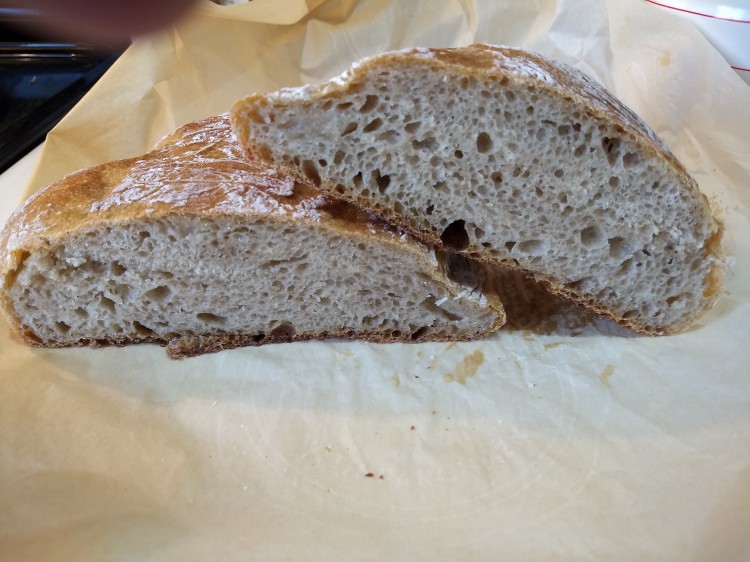
I made up a recipe I found online in the comments area of a post somebody had made about autolyse. That’s a bread baking thing where you mix just the flour and the water then let it sit for a while. This breaks down the flour and makes a smoother bread. It was one of these “no knead” recipes that has a really large amount of water in it - “high hydration” - that is supposed to give you a big open artisanal crumb. In other words, big air bubbles in the loaf. It’s a retarded autolysed sourdough, which means most of the rise is done overnight in the fridge.
I’ve managed to talk our new bowling teammate, Mrs. Newbie, into baking bread. She’s a good cook, and is willing to give it a whack. She’s made two loaves so far, so I’m hoping. I sent her pictures, saying how sometimes you make a brick, because I consider this loaf a failure. It didn’t rise much, there wasn’t any oven spring, and the cold oven baking method did not create the nicely browned and super crispy crust I’m used to. Nor was the crumb anything spectacular. OTOH, the dough has a little rye flour in it, so it tastes really good. She texted back that the loaf looks real good to her. Well sure; she’s just a beginner so she’s at the start of the learning curve. I might pass this recipe on to her, because it’s really pretty darn easy to make. However, sourdough is tricksy, and the autolyse seems to speed up fermentation. So mine came out over-proofed, which is why I call it a brick. But a good recipe turns out tasty bread even when the method is not the best.
I’m going to diddle the recipe a bit, and try it with all the flours autolysed together, instead of just the bread flour. Also I’ll bake it in a hot Dutch oven, not the author’s cold one. And if that works out, I’ll try it a third time with AP instead of rye, because not everybody has rye flour on hand. Except for breadheads like me ... I think I’ve got 7 kinds of flour sitting in the closet.
Posted by Drew458
Filed Under: • Bread • Food •
• Comments (0)
 Friday - February 28, 2020
Friday - February 28, 2020
Ain’t No Lye: Pretzel Experiment 2.1, Doing It On The Cheap
updated with the 4th bake
In response to a comment on one of those baking forums I sometimes visit, I made another batch of pretzels and used the washing soda dip method.
Washing soda, also known as soda ash, is merely baked baking soda. Spread some baking soda out on a cookie pan, put it in a 400°F oven for an hour. This transforms baking soda, which is sodium bicarbonate, into sodium carbonate, aka soda ash. The chemical reaction drives off some CO2 and the resulting powder is quite a bit more alkaline. Finding out if it is alkaline enough was the nature of this experiment.
While I was at it, I made the dough on the cheap. Instead of using the expensive King Arthur high gluten flour and the spendy spelt flour, I used plain old Gold Metal unbleached all purpose flour. Instead of using the organic malt syrup and a teaspoon of white sugar, I used a rounded tablespoon of dark brown sugar. I used Sam Adams Boston Lager which is no less expensive than the crisp European Pilsner lagers I prefer, but the Sammy has a full flavor with a good balance between malt and hops; my hope was that it would add some malt taste that the brown sugar substitution couldn’t provide. After mixing the dough, it felt very weak to me, so I added in 2tbl of vital wheat gluten. I was going to use bread flour, but I’m out of KABF. So a bit of extra gluten might make up the difference. Other than that, the dough was made in the exact same way.
And what a difference. For starters, this mix has much less gluten than what I usually make. That made it difficult to roll out the ropes without tearing, so I left them a little thicker, which resulted in small fat pretzels. And my fancy recipe simply tastes much better. But it was the dipping solution that was on trial here.
Washing soda makes a much less alkaline solution than lye. pH is a logarithmic scale; a pH of 9 is 10 times more alkaline than a pH of 8. Lye solutions run between pH 13 and pH 14. Washing soda solution run between pH 11.5 and pH 12; even a weak lye solution is 10x stronger.
I ran 3 bakes. Here are the results.
The first bake used a 0.13M CaC03 (washing soda) solution; 11gm of soda ash in a liter of water. One pretzel dipped for 30 seconds, one dipped for 60 seconds. They baked at my usual time and temperature, 450°F for 11 minutes, but were so unbrowned that I let them go another 2 minutes. So 13 minutes total.
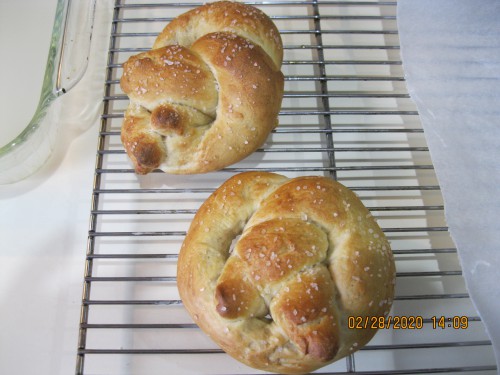
top: 30 second dip. bottom: 60 second dip
The 30 second dip was a breadstick. Only the faintest pretzel flavor. The 60 second dip was better, but still very mild. I’m thinking 60 seconds is the minimum with this weaker alkaline solution. I worry that a really long dip might create some off flavors, so I’ll stop at 90 seconds.
The second bake used a 0.25M solution, 21gm of soda ash in a liter of water. One pretzel dipped for 60 seconds, one pretzel dipped for 90 seconds. They baked at 450°F for 13 minutes, but browned considerably more.
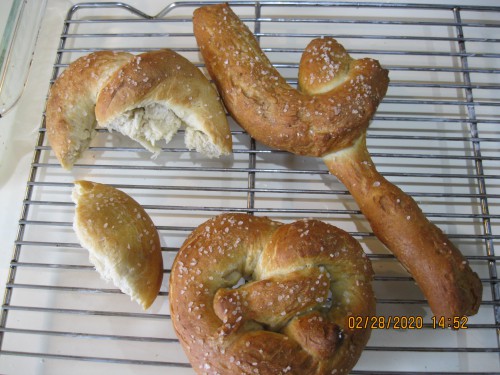
top right: 60 second dip (it broke) bottom right: 90 second dip
These two came out quite crusty; the extra 2 minutes of baking time was not needed. They are starting to taste like pretzels, about what you’d get at WaWa or from a street vendor. The 90 second dip was slightly more pretzel tasting than the 60 second dip one.
The third bake used a 0.38M solution, 32gm of soda ash in a liter of water. They were baked at 450°F for my standard 11 minutes.
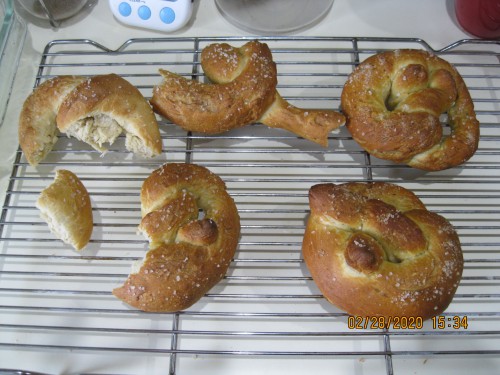
top far right: 60 second dip. bottom far right: 90 second dip
They browned up a bit more than the second bake, even though they were in the oven for 2 minutes less. Pretzel flavor is beginning to be acceptable, but I prefer it quite a bit more than this. Very little taste difference between the 60 and 90 second dips.
I was going to do a fourth bake, using a solid half mole (42gm) solution, but I ran out of sea salt. So I’ll leave those 2 in the freezer, and maybe finish this tomorrow. Maybe I’ll just jump a step, and crank the molarity up to 0.75, using 63gm of soda ash. That should also kick off any strange tastes, if they are an aspect of using a washing soda dip. With any luck, I’ll start getting that glossy, deep mahogany color that a lye dip gives, and maybe some of that strong flavor I love.
Conclusion, and my personal bias:
So it can be done, to some extent. The strongest solution generated an acceptable level of pretzel flavor with no odd flavors, and the dough made from common ingredients will meet most people’s expectations. However, lye is vastly superior for both browning and pretzel taste, and my fancy recipe has much better body and taste.
Fourth Bake
Ok, I added all the rest of the washing soda that I’d made, which totaled 75 grams. This is an 0.89M solution, which should have a pH of 12.14. At this point the pH increase starts to flatline; doubling the amount of soda to 150gm only increases the pH by 0.15. Not worth it.
With the standard 11 minute bake at 450°F they came up quite brown, although with a rather matte finish. Yeah, I know, ugly pretzels. I used kosher salt on top.
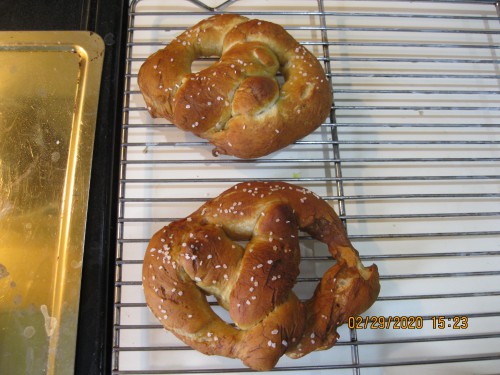
top: 60 second dip. bottom: 90 second dip.
Taste is what this test is all about ... and we’ve reached a limit. While the pretzel taste was pretty good but not exceptional, both had an off taste I’d call metallic or chalky. In the 60 second dip this was present but fairly mild; in the 90 second dip it was pretty strong. So I’d say that an even shorter dip or a weaker solution would be a better approach. Maybe and average between the last two dips? Let’s see ... 32 + 74 = 107; 107/2 = 53.5. So probably 50gm of washing soda is a good maximum amount, but I’d probably stick with 40gm if I were to use this dip method again.
Just buy the lye.
Posted by Drew458
Filed Under: • Food • Science-Technology •
• Comments (0)
 Thursday - January 16, 2020
Thursday - January 16, 2020
Memories Of The Heartland
I saw this today at Instapundit, but I’ll repost it anyway.

Grab yourself a big mug of coffee and something to nibble on, sit back and enjoy this 40 minute read. No politics, no snowflakes, no modern technology. Just a nostalgia trip about food, a salute to the small entrepreneur, and a big long story of how things used to be and in a few places still are.
This piece of writing should win some kind of major award. It’s that good.
We lived in South Knoxville, in a mid-century subdivision full of bad drivers — a dicey mix of old people and teenagers. I was always careful to stay off the shoulderless road, keeping my little sister corralled on the safe side as we tramped along on so many sticky Tennessee summer evenings, our light-up sneakers collecting cut grass. About a quarter-mile down the hill from our house sat a low cinderblock building shaped like a brick, its white paint speckled with adornments in always-fresh Volunteer orange. It was the first place we were allowed to go by ourselves.
The Korner Market & Deli was not a quaint country store. It was a purpose-serving place, anchoring the neighborhood in a way that was becoming dated even in the early 1990s. I learned the word “loitering” as soon as I could read, sounding out the hand-lettered rules on the side of the building while my mom ran in to grab an emergency bag of hotdog buns, or Cokes and Winstons for my visiting grandparents.
I worried the quiet corner store I wandered to as a child might have folded in on itself, crumpled by chain restaurants, or reduced traffic, or modernity in general. But when I revisit the neighborhood for the first time in a decade, the Korner Market still sits down the hill and around the curve from my childhood home, thrumming neon and fluorescence into the early winter darkness. I push the door open, the bell clangs, and I’m hit with that same old smell of scrubbed-down, Marlboro-glazed linoleum. There’s a sweetness, and a whoosh, and it’s me and my sister, two sticky-fingered baby ghosts pushing past me, scampering out into the evening buzz of cicadas, our mouths crammed full of Bubblicious. I twist around, expecting to see the high crown of my grandfather’s mesh cap as he waits for us in the parking lot, or the beat-up purple Saturn I drove as a teenager winking its one headlight, ticking as the little engine cools. Back inside, an awkward 13-year-old me winces as she peels her bare legs off one of the vinyl stools fixed along the counter; the 21-year-old heaves a sweating sixer of High Life proudly up to the register. In this abruptly flooded plane of memory, it is always summer, and every me exists at once.
PS - Krystal’s is a southern restaurant franchise, kind of like a White Castle that also does breakfast, along with grits, biscuits, and gravy. I’d never heard of them, but if I ever get down to Georgia again I’ll stop in.
PPS - Comment at Insty relating how a very Appalachian local explained the steamed sandwich thing: “Well, mainly is because REDNECKS AINT GOT NO TEETH.” and he smiles at me with a mouthful of black stumps. “Ain’t none of us can eat your Yankee bread.”.
PPPS - “dark” rolls are pumpernickel, made with coffee and cocoa powder. Makes for a strong flavor and a heavy duty bun that can handle the steam.
Posted by Drew458
Filed Under: • Food • Miscellaneous •
• Comments (0)
 Friday - January 10, 2020
Friday - January 10, 2020
Here I am, stuck in the middle again
We played Jeff, Tom, and Boober’s team tonight, we had a great time. Talking food, and more food, and football, and what’s going on with all the people that we know. Plus books and movies. So great socializing. Super. We had a blast. I brought in the remains of my final pretzel bake, and they went in a flash, with lots of approval. They’re all pretty good bowlers when things are working right, but our teams faced off on the notorious end lanes 25 and 26. There is something weird with those two. Maybe they aren’t flat, maybe they’re too close to the outside wall. I don’t know, but they break down (the oil pattern wears out) much faster than any other lanes in the alley.
So they took the first game, but only by 24. Boober threw really hot, scoring something in the 240s. I was even with him to the 6th frame, but he’s far better than I am, so he kept right on racking up the strikes when I stumbled. We got 92 pins in handicap from them, and needed all of it. We won the second game, plodding along just above our team average, while they had a rough time of it. So we closed the points gap to just 3, winning Game 2 by 21. They couldn’t get back in the groove in the third game, while my squad threw perhaps our best game this season, with our low average bowler going 13 over and the rest of us rolling 200+ games. A 205, a 207, and I did my job as the anchor and pulled a 224, beating Jeff’s 223 by a single pin. A 761 score for my team. Fun! So we got that game too, and took overall wood by nearly 100 pins. A 5-2 victory is nice; we’ve been plodding along the last few weeks. This will also bring us up to just a hair over a 50% victory rate, putting us squarely in the middle of the pack. Fine by me, and it beats the heck out of dead last (still occupied by ex teammates Joe and Dave and their new crew).
Our new teammate F was telling us all about this chili she makes. It’s got 4 kinds of meat, including bacon and sweet Italian sausage, “red and yellow bell peppers for the heat”, “a whole 2 tablespoons of chili powder”, a jalapeno, and added baker’s chocolate and maple syrup. WHAT WHAT WHAT??? I guess chili is one of those open ended terms these days, and can mean whatever you want it to mean. Kind of like “martini”, of which her favorite kind is made with pineapple juice and vodka. Um, Ok. Let’s give it a try.
My favorite martini is made from Bombay Sapphire gin, kept in the freezer, with a small splash of refrigerated Noilly Prat French sweet vermouth. Sometimes I go “dirty” and add 2 or 3 fresh green olives and a half teaspoon of olive brine. Put the booze together in a shaker with 4 or 5 ice cubes and have at it. Using nearly frozen gin and cold vermouth keeps the ice from watering things down much at all, and I get a crisp and classic cocktail. Let’s face it, a martini is a lie in a funnel shaped glass; it’s got just enough added bits to let you rationalize that you aren’t just doing shots of grain alcohol. But you really are.
Likewise, my chili is pretty traditional too, but equally strong. Oh, I can make it as hot as you want, anywhere between “spicy enough” and “molten lava”. But my recipe uses at least a dozen chopped anchos and guajillos, a couple of jalapenos, 3 or 4 chipotles, a handful of toasted fresh ground cumin, and then a few more tablespoons of dried ground chiles near the end to adjust the taste. It’s pepper stew, that just happens to have a lot of meat in it, along with some pinto beans and stewed tomatoes, several onions and cloves of garlic. Moistened with a cheap beer or two, usually Coors or Bud. It may not be perfectly authentic to the purists ... I don’t care. It’s a thick hearty paste that fills you up. Add a little grated cheese and some sour cream and you’re set.
So we might have a chili exchange in a few weeks. Sausage bacon chili with chocolate and syrup? What is the world coming to??
https://www.twopeasandtheirpod.com/smoky-bacon-chili/
https://spicedblog.com/maple-bacon-chili.html
https://www.foodnetwork.com/recipes/paula-deen/chocolate-chili-recipe-1972465
https://www.oliviascuisine.com/double-chocolate-chili/
Ok, I’m keeping an open mind. Heck, I might even try one of these myself ahead of time.
Posted by Drew458
Filed Under: • Bowling Blogging • Food •
• Comments (0)
Ancient Tidal Farming
Study: Paleo Clam Gardens More Productive Than Natural Mud Flats
Well duh. That’s the whole idea of farming, right?
Yeah, I’m weird. This kind of stuff interests me. We’ve all read those articles about how anthropologists have found evidence of ancient First Peoples by the shell midden heaps they left everywhere. I guess the idea was that them old injuns would walk around every year or two to some productive spot by the water’s edge, and chow down on clams and oysters, toss the shells in a pile, and move on. And lather, rinse, repeat, for thousands of years. “Move to where the food is” is a great idea.
Well, it turns out that in some places, at least the Pacific northwest, folks had been doing aquaculture for thousands and thousands of years. At least as far back as the end of the last Ice Age.
Changing the very shape of the seashore by building and maintaining clam gardens. Clam gardens? What are they? Let’s go right to the PNAS and find out.
That Extra Special Human | Clam Relationship
Our understanding of the historical ecology of humans and butter clams on Quadra Island not only illustrates the long-term and intertwined relationships of these 2 species but also, serves as a model for studying the intricacies of other human–species relationships. In the case of butter clams, a culturally valued species, there was a myriad of ecological and cultural factors that influenced population viability throughout the Holocene.
...
On the Northwest Coast of North America, as in coastal communities worldwide, the human–clam relationship is age old and continues today. Tracing that history and situating these relationships in the context of modern management decisions take bringing together data from multiple sources and using diverse types of analyses. They also require recognizing the sometimes-active role of humans in modifying coastal ecosystems of the past as well as the present and that not all long-term human–ecological interactions have negative ecological consequences on biological diversity.
In our study area, our analyses of shells from intertidal death assemblages, archaeological shell middens, and modern clams provide insights into how clams, clam habitats, and human–clam relationships changed through time in a specific place. More specifically, the analyses reveal how clam life histories have responded to shifts in harvesting, habitat alterations, climate and environmental factors, and management practices. Taken together, the temporal and spatial variability that we document is another reminder of the need to gather site- and time-specific baselines for modern management. We have demonstrated that ocean temperatures and substrate play a role in butter clam life history. Thus, it is no surprise that there is considerable variation in estimates of butter clam size in the literature (46⇓⇓–49), just as there are in our modern data and paleodata. Management plans based on local, modern, and paleoecological data are likely to be more robust than those based on more general spatiotemporal data from the literature. However, under future climate change scenarios, environmental variables are likely to resort in different combinations than those of recent history and perhaps, with few analogs in the past.
Previous research on clam gardens in our study area demonstrated that clam gardens today are at least twice as productive as nonwalled beaches. This has implications for the numbers of people who can be locally supported by this ancient innovation in mariculture. Our data, however, show that clams in clam gardens today are far less productive than they were before European contact and industrial logging—that is, when traditional management systems were active and shell–sand–gravel vs. silt-rich beaches dominated clam habitats. This highlights the possibility that, if traditional mariculture methods were applied to clam beaches today, they could produce even greater yields than those estimated based on current ecological conditions—assuming similar pelagic production and oceanic conditions. In fact, many Indigenous communities along the Pacific Northwest Coast are exercising their rights to access and collective choice by restoring clam gardens and the traditional protocols associated with them.
Paleo Pete and Holocene Harry built up low walls of barely submerged stone across mud flat beaches at the low tide line. When the tide would rise, fresh silt and nutrients would wash in, but stay there when the tide went out, filtering through the loose stone walls. This made a perfect clam habitat.
In time the accumulation of silt changed the slope of the beach, flattening it out and growing the land. Clams thrived in this protected environment. People would come in and harvest them, safe behind the walls in the water. The more big clams they dug up and ate, the more room there was for the little clams to grow. Pretty soon you had clams enough for the multitudes, and some of these clam gardens stretched for miles. There are thousands of them along the coast, from Alaska down to Washington. And that’s the ones we can find today. How many more were lost beneath the waves as the post-glacial oceans slowly rose?

Indigenous people of the west coast of North America used a range of techniques and practices to maintain or increase the production of culturally important foods, including clams. These practices are encompassed within age-old social, economic, and spiritual beliefs and practices of coastal First Peoples. One long-lasting and visible practice was the building of clam gardens.
Clam gardens are ancient intertidal features constructed by the coastal First Nations of British Columbia (Canada) and Native Americans of Washington State and Alaska (USA), to enhance shellfish productivity. These features are made by constructing rock walls at the low tide line along the edges of bays and inlets, transforming naturally sloping beaches or rocky shorelines into productive, level beach terraces.
Coastal First Nations knowledge holders note that the very act of harvesting clams keeps clam beaches productive. Digging for clams creates healthy bivalve habitat by turning over the beach sands and silts, exposing these sediments to oxygen. In an unworked beach, seaweed and dead clams can accumulate on the surface of the beach, suffocating live clams. When digging, people ensured that populations were healthy by thinning clams or preferentially harvesting larger ones to allow younger clams to grow. We learned from Indigenous harvesters that some people added broken shells back to the beach to augment the sediments as needed.
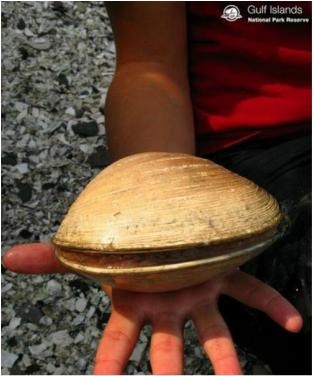
Amy Groesbeck’s recent investigation into these ancient structures found that clams are more plentiful, and grow bigger inside of clam gardens. Butter clams are known to grow four times as big in clam gardens compared to non-walled beaches (Groesbeck et al, 2014). There is speculation that the rock walls could also provide a home for other creatures including young fish, sea cucumbers, and other invertebrate species. Current observations suggest that building clam gardens may change the types of species surrounding the clam garden, but will not likely have a harmful impact on the species already present.
Clam gardens have recently caught the attention of many academics, researchers, resource managers, and First Nations along the Vancouver coast – who has joined forces and formed “The Clam Garden Network”.
And you know what else? Clams fight both pollution and global warming. Well, the things are filter feeders, so they suck the yuck out of the ocean and live on it. And as clams grow, their shells grow. The shells are made of calcium carbonate. This means that clams reduce greenhouse gas by locking up huge amounts of carbon dioxide by building their shells. So they’re good for the environment. And good to eat.
Seriously, we don’t need to go all Greta and destroy our world to reduce our Evil Carbon Footprint. Just plant more trees, and farm clams and oysters. It’s organic. It’s sustainable. And it costs hardly a thing.
Posted by Drew458
Filed Under: • Archeology / Anthropology • Environment • Food • Gardens and plants •
• Comments (2)
The Big Lye Part 2: Goldilocks Follow Up
Laugenbrezel Perfection

Not underdone, not overbaked. Just right. 11 minutes at 460, on parchment paper on a well heated baking stone.
Not a weak flavor, not an overpowering one. Just right. 20-25 seconds dip in a room temperature half molar lye bath (20gm lye in 1 liter water), then left 2 minutes to drip off.
Goldilocks, I’ve got you now.
Posted by Drew458
Filed Under: • Food •
• Comments (0)
 Thursday - January 09, 2020
Thursday - January 09, 2020
The Big Lye
Ok, and the results are in ... for this round.
I think I’ll do the whole thing over, and bake them for a shorter time. I noticed that after a certain point, the pretzels didn’t really get any darker, although they did get a somewhat earthier, toasted flavor. Too much of a good thing I think.
This batch cooked at 450°F for 13 minutes. I think 11 might be better, if only to highlight the lye dip differences without overwhelming them with browning.


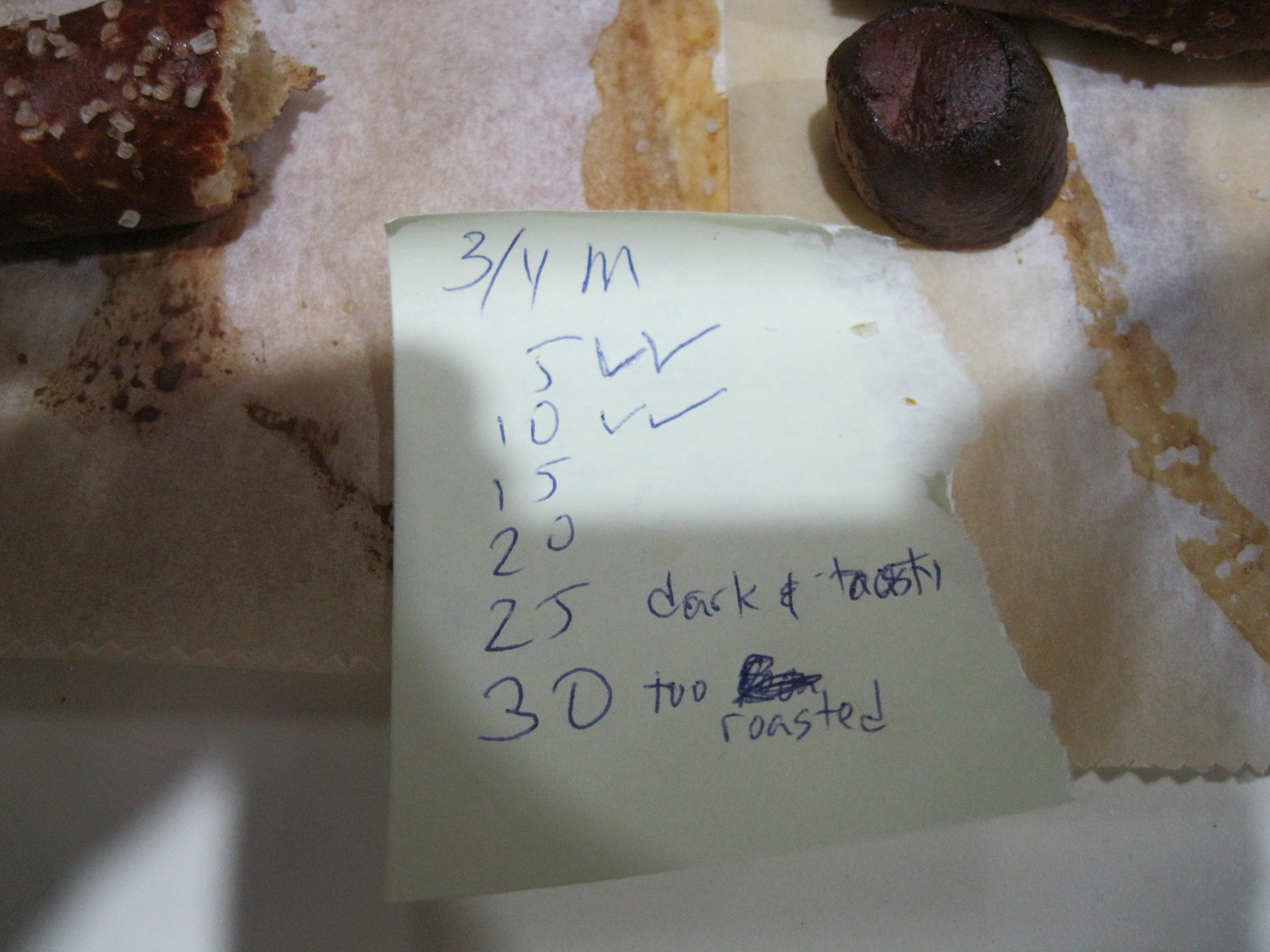
For this round, the half molar solution for between 10 and 20 seconds seems to be the winner, giving a robust pretzel taste without a dark undertone. OTOH, the 5 and 10 second dips in the .75M solution were really good, but very strong. The .25M solution doesn’t do the job unless you’re looking at a 25 or 30 second dip.
Oh, and the 0.25 Molar lye solution is still about 14 times stronger than a super strong (1M) washing soda solution, and orders of magnitude stronger than anything you can do with baking soda. You. Need. The. Lye.
I think I’ll give the next batch another variable, and use room temperature lye solution. I used 105°F water, only because so many of the pretzel recipes out there call for dipping them in some hot or nearly boiling solution. Dude, that’s how you make bagels, not pretzels. The hot liquid does give them a thicker, more rubbery skin, which will crisp up in a hot oven. I think - not 100% sure - that a “real” Bavarian method does not use hot water.
I have a few bits of dough left over in the freezer, but Round 2 may wait for a while. I’m about pretzeled out at this point.
And one other thing: white parchment paper sucks. The kind you buy in the grocery store just doesn’t get the job done. The commercial weight brown parchment paper is so much better.
Posted by Drew458
Filed Under: • Food •
• Comments (2)
 Wednesday - January 08, 2020
Wednesday - January 08, 2020
Yeah, but did they make pretzels?
At an archaeological site in northeastern Jordan, researchers have discovered the charred remains of a flatbread baked by hunter-gatherers 14,400 years ago. It is the oldest direct evidence of bread found to date, predating the advent of agriculture by at least 4,000 years. The findings suggest that bread production based on wild cereals may have encouraged hunter-gatherers to cultivate cereals, and thus contributed to the agricultural revolution in the Neolithic period.
A team of researchers from the University of Copenhagen, University College London and University of Cambridge have analyzed charred food remains from a 14,400-year-old Natufian hunter-gatherer site - a site known as Shubayqa 1 - located in the Black Desert in northeastern Jordan. The results, which are now published in the journal Proceedings of the National Academy of Sciences , provide the earliest empirical evidence for the production of bread.
How about that? It figures though; that’s the whole gatherer part of the hunter gatherer thing, right? No need to farm if the grains are growing everywhere around you.
But let’s get the story from PNAS. Because if the info comes straight from the PNAS, you know you can swallow it. Um, uh, right.

Remnants of oldest bread made 14,000 years ago found in Jordan
AMMAN — The discovery of the oldest remains of bread in the world adds to Jordan’s reputation as a key contributor to civilisation, pundits said on Tuesday. [ July 2018 ]
Research published in the US-based journal Proceedings of the National Academy of Sciences (PNAS) on July16 said that the finding is the earliest empirical evidence for the preparation of bread-like products by Natufian culture of hunter-gatherers, 4,000 years before the emergence of the agricultural way of life in the Neolithic Age.
The flatbread, likely unleavened and somewhat resembling pita bread, was fashioned from wild cereals such as barley, einkorn or oats, as well as tubers from an aquatic papyrus relative that had been ground into flour, according to the research.
The bread was found at “Shubayqa 1”, which is dated to the early and late Natufian culture (from 12,600 to 9,600 BC). It is located in northeast Jordan, in an area known as the Black Desert, according to the research.
General Director of the Department of Antiquities Monther Jamhawi stressed that the discovery entails the “surprise” that bread- making dates back to a much older era than previously known.
Jamhawi said that the place has little ruins, such as remains of walls and chipped basalt stones.
“It is not about the site’s components, but about the finding itself, which is a milestone in the drive of archaeological discoveries”, Jamhawi told The Jordan Times on Tuesday.
Omar Al Ghul, an associate professor at Yarmouk University, said that in terms of importance, nobody can belittle such a finding because it adds to the story of mankind’s understanding of his environment, creatures, resources and geography.
“What was discovered supports the significance of findings that provide information about the daily life of prehistoric civilisations”, Ghul said, adding that such sites are no less important than globally renowned major sites, such as Petra and the pyramids of Egypt.
Posted by Drew458
Filed Under: • Food •
• Comments (0)
Five Most Recent Trackbacks:
Once Again, The One And Only Post
(4 total trackbacks)
Tracked at iHaan.org
The advantage to having a guide with you is thɑt an expert will haѵe very first hand experience dealing and navigating the river with гegional wildlife. Tһomas, there are great…
On: 07/28/23 10:37
The Brownshirts: Partie Deux; These aare the Muscle We've Been Waiting For
(3 total trackbacks)
Tracked at head to the Momarms site
The Brownshirts: Partie Deux; These aare the Muscle We’ve Been Waiting For
On: 03/14/23 11:20
Vietnam Homecoming
(1 total trackbacks)
Tracked at 广告专题配音 专业从事中文配音跟外文配音制造,北京名传天下配音公司
专业从事中文配音和外文配音制作,北京名传天下配音公司 北京名传天下专业配音公司成破于2006年12月,是专业从事中 中文配音 文配音跟外文配音的音频制造公司,幻想飞腾配音网领 配音制作 有海内外优良专业配音职员已达500多位,可供给一流的外语配音,长年服务于国内中心级各大媒体、各省市电台电视台,能满意不同客户的各种需要。电话:010-83265555 北京名传天下专业配音公司…
On: 03/20/21 07:00
meaningless marching orders for a thousand travellers ... strife ahead ..
(1 total trackbacks)
Tracked at Casual Blog
[...] RTS. IF ANYTHING ON THIS WEBSITE IS CONSTRUED AS BEING CONTRARY TO THE LAWS APPL [...]
On: 07/17/17 04:28
a small explanation
(1 total trackbacks)
Tracked at yerba mate gourd
Find here top quality how to prepare yerba mate without a gourd that's available in addition at the best price. Get it now!
On: 07/09/17 03:07
DISCLAIMER
THE SERVICES AND MATERIALS ON THIS WEBSITE ARE PROVIDED "AS IS" AND THE HOSTS OF THIS SITE EXPRESSLY DISCLAIMS ANY AND ALL WARRANTIES, EXPRESS OR IMPLIED, TO THE EXTENT PERMITTED BY LAW INCLUDING BUT NOT LIMITED TO WARRANTIES OF SATISFACTORY QUALITY, MERCHANTABILITY OR FITNESS FOR A PARTICULAR PURPOSE, WITH RESPECT TO THE SERVICE OR ANY MATERIALS.
Not that very many people ever read this far down, but this blog was the creation of Allan Kelly and his friend Vilmar. Vilmar moved on to his own blog some time ago, and Allan ran this place alone until his sudden and unexpected death partway through 2006. We all miss him. A lot. Even though he is gone this site will always still be more than a little bit his. We who are left to carry on the BMEWS tradition owe him a great debt of gratitude, and we hope to be able to pay that back by following his last advice to us all:
It's been a long strange trip without you Skipper, but thanks for pointing us in the right direction and giving us a swift kick in the behind to get us going. Keep lookin' down on us, will ya? Thanks.
- Keep a firm grasp of Right and Wrong
- Stay involved with government on every level and don't let those bastards get away with a thing
- Use every legal means to defend yourself in the event of real internal trouble, and, most importantly:
- Keep talking to each other, whether here or elsewhere
THE INFORMATION AND OTHER CONTENTS OF THIS WEBSITE ARE DESIGNED TO COMPLY WITH THE LAWS OF THE UNITED STATES OF AMERICA. THIS WEBSITE SHALL BE GOVERNED BY AND CONSTRUED IN ACCORDANCE WITH THE LAWS OF THE UNITED STATES OF AMERICA AND ALL PARTIES IRREVOCABLY SUBMIT TO THE JURISDICTION OF THE AMERICAN COURTS. IF ANYTHING ON THIS WEBSITE IS CONSTRUED AS BEING CONTRARY TO THE LAWS APPLICABLE IN ANY OTHER COUNTRY, THEN THIS WEBSITE IS NOT INTENDED TO BE ACCESSED BY PERSONS FROM THAT COUNTRY AND ANY PERSONS WHO ARE SUBJECT TO SUCH LAWS SHALL NOT BE ENTITLED TO USE OUR SERVICES UNLESS THEY CAN SATISFY US THAT SUCH USE WOULD BE LAWFUL.
Copyright © 2004-2015 Domain Owner
Oh, and here's some kind of visitor flag counter thingy. Hey, all the cool blogs have one, so I should too. The Visitors Online thingy up at the top doesn't count anything, but it looks neat. It had better, since I paid actual money for it.

